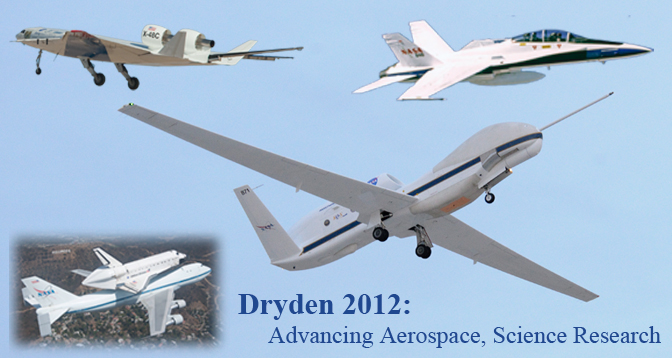
EDWARDS, Calif. – NASA’s Dryden Flight Research Center at Edwards Air Force Base, Calif., helped advance the agency’s overall mission of Earth and space science and aerospace technology research as it continued supporting NASA’s four mission areas during 2012.
Aeronautics
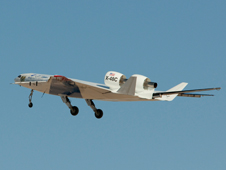 The X-48C Hybrid / Blended Wing Body technology demonstrator lifts into the skies after taking off from the bed of Rogers Dry Lake at Edwards Air Force Base on its first test flight on Aug. 7, 2012. (NASA / Carla Thomas) › View Larger Image
The X-48C Hybrid / Blended Wing Body technology demonstrator lifts into the skies after taking off from the bed of Rogers Dry Lake at Edwards Air Force Base on its first test flight on Aug. 7, 2012. (NASA / Carla Thomas) › View Larger Image
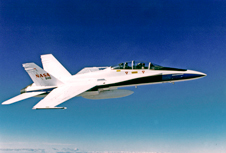 NASA Dryden’s F/A-18B No. 846 flew the majority of flights during several sonic-boom mitigation research projects in 2012. (NASA photo) › View Larger Image
NASA Dryden’s F/A-18B No. 846 flew the majority of flights during several sonic-boom mitigation research projects in 2012. (NASA photo) › View Larger Image
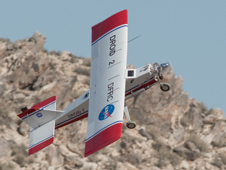 NASA Dryden’s DROID research aircraft executes a hard right climbing turn to avoid crashing into a rocky desert ridge during flight tests of a ground collision avoidance system for small unmanned air vehicles. (NASA / Tom Tschida) › View Larger Image X-48 Blended/Hybrid Wing Body
NASA Dryden’s DROID research aircraft executes a hard right climbing turn to avoid crashing into a rocky desert ridge during flight tests of a ground collision avoidance system for small unmanned air vehicles. (NASA / Tom Tschida) › View Larger Image X-48 Blended/Hybrid Wing Body
The remotely piloted “C” version of the X-48 Blended Wing Body sub-scale research aircraft successfully flew for the first time on Aug. 7. The new X-48C model was modified from its earlier X-48B configuration to evaluate the low-speed stability and control of a low-noise version of a proposed future Hybrid Wing Body (HWB) aircraft design.
The project’s 100th flight milestone occurred Oct. 30 when the X-48C made its seventh and eighth flights. Between 2007 and 2010, the aircraft, then in the X-48B configuration, made 92 flights. Designed by the Boeing Co. and built by Cranfield Aerospace Ltd. of the United Kingdom, the X-48 is flying in partnership with NASA.
Sonic Boom Research
In November, Dryden flew a series of low-supersonic, high-altitude flight profiles during the Farfield Investigation of No Boom Threshold, or FaINT, flight research project. The effort, involving several NASA centers, industry and university partners, collected data to expand the collective knowledge of sonic boom propagation effects to provide the data necessary for engineers to design future low-boom supersonic aircraft. The overarching goal of NASA’s sonic boom reduction research is to shrink the sonic boom “footprint” in order to make civil supersonic flight over land practical.
Automatic Ground Collision Avoidance System
Dryden researchers successfully conducted flights tests of a miniature automatic ground collision avoidance system (Auto-GCAS) for small unmanned aircraft last May. During final test flights of the software integrated into an autopilot on the Dryden Remotely Operated Integrated Drone (DROID) research aircraft, the smartphone-assisted system consistently commanded evasive maneuvers when it sensed the aircraft was getting too close to rocky, mountainous terrain or ridgelines and impact with the terrain was imminent.
UAS in the NAS
On March 15, Dryden completed the first flights in the Unmanned Air Systems in the National Airspace (UAS in the NAS) project, using the unmanned MQ-9 Ikhana aircraft for evaluation of the Automatic Dependent Surveillance-Broadcast (ADS-B) aircraft tracking system adapted for UAS. All aircraft operating in certain U.S. airspace must adopt ADS-B aircraft tracking technology by January 2020 in order to comply with Federal Aviation Administration regulations. The flight was the first time an unmanned aircraft as large as the MQ-9 had flown equipped with ADS-B. The initial flights checked out the system’s capabilities in the “out” or transmit mode, while more recent flights evaluated the system’s “in” or receive data mode and its ability to downlink information to the ground control station.
Earth and Space Science
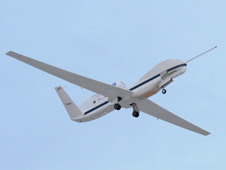 NASA Global Hawk No. 871 was one of two NASA Global Hawk unmanned aircraft systems that participated in NASA’s HS-3 hurricane study over the Atlantic during 2012. (NASA / Tony Landis) › View Larger Image HS3 Mission
NASA Global Hawk No. 871 was one of two NASA Global Hawk unmanned aircraft systems that participated in NASA’s HS-3 hurricane study over the Atlantic during 2012. (NASA / Tony Landis) › View Larger Image HS3 Mission
The 2012 Hurricane and Severe Storm Sentinel, or HS3, mission in September saw a NASA Global Hawk aircraft fly from the agency’s Wallops Flight Facility in Wallops Island, Va., to investigate the environment and cloud structure of hurricanes Leslie and Nadine in the Atlantic Ocean. This was the first deployment from Wallops for the Dryden-based aircraft, which flew more than 148 hours during six HS3 science flights.
Operation IceBridge
Researchers with NASA’s Operation IceBridge completed a five-week Antarctic field campaign this fall aboard the agency’s DC-8 airborne science laboratory from Punta Arenas, Chile. From Oct. 12 to Nov. 8, researchers gathered valuable information on land and sea ice during 16 science missions over Antarctica. During this year’s fourth annual Antarctic campaign, IceBridge scientists added to existing sea ice elevation data, surveyed new areas of the Antarctic ice sheet and reached out to students, teachers and the public.
ER-2 Missions
NASA’s high-altitude ER-2 aircraft flew a number of missions this year, including deployments to Iceland and the agency’s Wallops Flight Facility for research using a new laser altimeter dubbed MABEL. The Multiple Altimeter Beam Experiment Lidar was developed at NASA’s Goddard Space Flight Center to simulate a similar instrument planned for NASA’s IceSat-2 satellite that is scheduled for launch in 2016.
UAVSAR
The Uninhabited Aerial Vehicle Synthetic Aperture Radar, or UAVSAR, flies aboard NASA’s C-20A aircraft. Missions in 2012 included glacier research of Iceland’s ice caps; volcano studies in Hawaii, Alaska, Japan and in the Cascade Range in Oregon and Washington; landslide imaging in Colorado; soil moisture studies in the U.S. Midwestern states, and flights over earthquake faults in the Southwest.
SOFIA Observatory
NASA’s Stratospheric Observatory for Infrared Astronomy (SOFIA) began checkout and validation flights in early December after undergoing major upgrades to its mission command and control system and avionics systems during most of the year. The flying observatory is slated to begin its Cycle 1 series of astronomical observations with its first-generation instruments in spring 2013.
Spaceflight Technology
Flight Opportunities Program
NASA’s Flight Opportunities Program sponsored the first successful free flight of a new control system for Masten Space Systems’ Xombie suborbital vertical landing demonstrator on Feb. 2 at the Mojave Air and Space Port, Mojave, Calif. The flight used a new flight control system concept that will enable future demonstrations of landing technologies needed for exploration of planets and moons, as well as near-Earth objects, like asteroids.
The Flight Opportunities program’s mission is to oversee the integration and flight of a variety of technology payloads on commercial suborbital reusable vehicles near the boundary of space to help meet the agency’s research and technology needs.
Facilities Improvements
Construction of the new Facilities Support Center at NASA Dryden is proceeding apace, with underground infrastructure and masonry complete and erection of structural steelwork nearing completion. According to Dryden project architect Gemma Flores, construction of the $11.2 million, 38,000-square-foot structure is more than 50 percent finished, with expected completion by July 2013.
Space Shuttle Endeavour’s Final Journey
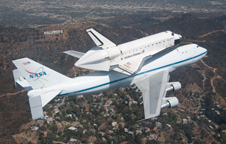 NASA Shuttle Carrier Aircraft 905 carries space shuttle Endeavour over the Hollywood Hills during the last leg of its final ferry flight into history, delivering it to the California Science Center in Los Angeles on Sept. 21, 2012. (NASA / Jim Ross) › View Larger Image The highlight of the year for the public and for many NASA Dryden staffers as well was the stopover of space shuttle Endeavour and its modified NASA 747 Shuttle Carrier Aircraft Sept. 20 during its final ferry flight from the Kennedy Space Center to Los Angeles, where it was turned over to the California Science Center for museum exhibit.
NASA Shuttle Carrier Aircraft 905 carries space shuttle Endeavour over the Hollywood Hills during the last leg of its final ferry flight into history, delivering it to the California Science Center in Los Angeles on Sept. 21, 2012. (NASA / Jim Ross) › View Larger Image The highlight of the year for the public and for many NASA Dryden staffers as well was the stopover of space shuttle Endeavour and its modified NASA 747 Shuttle Carrier Aircraft Sept. 20 during its final ferry flight from the Kennedy Space Center to Los Angeles, where it was turned over to the California Science Center for museum exhibit.
Following an overnight stay at Dryden, the SCA and Endeavour saluted the communities of Palmdale, Lancaster, Rosamond and Mojave with low-level flyovers before heading north to Sacramento and the San Francisco Bay Area on its Tour of California. More than two million people were estimated to have watched the SCA-Endeavour combo during low-altitude flyovers of famed landmarks in both Northern and Southern California, with extensive media coverage giving millions more the opportunity to watch the flyovers and the subsequent overland journey through Los Angeles to the science center museum three weeks later.
NASA Dryden supported the science center’s grand opening of the Endeavour exhibit on Oct. 30 and the related six-day SpaceFest. NASA had more than three dozen exhibits, displays, and educational demonstrations honoring aeronautics and space exploration past, present, and future.
For more about NASA Dryden Flight Research Center, visit:
https://www.nasa.gov/centers/dryden
– end –
text-only version of this release
To receive status reports and news releases issued from the Dryden Newsroom electronically, send a blank e-mail message to dfrc-subscribe@newsletters.nasa.gov. To unsubscribe, send a blank e-mail message to dfrc-unsubscribe@newsletters.nasa.gov. The system will confirm your request via e-mail.
Gray Creech
NASA Dryden Flight Research Center
661-276-2662
<a data-cke-saved-href=”mailto:” href=”mailto:” gray.creech@nasa.gov”=””>gray.creech@nasa.gov




























